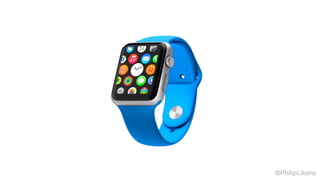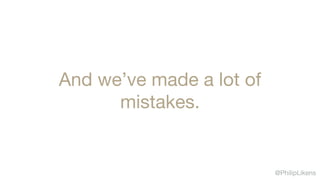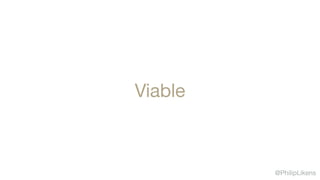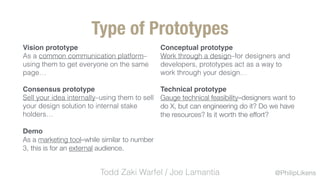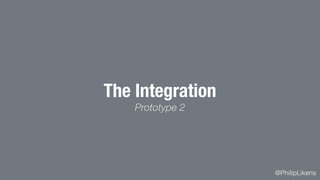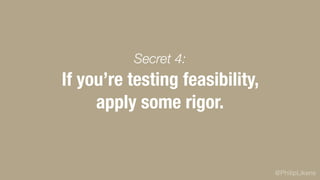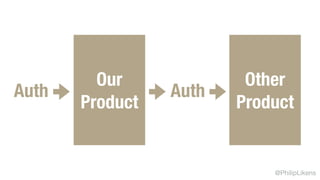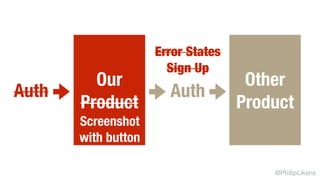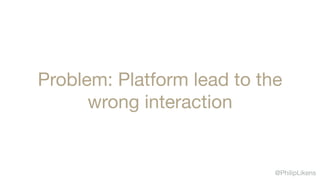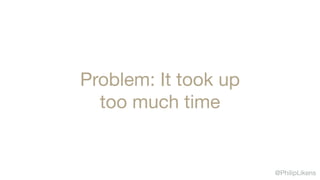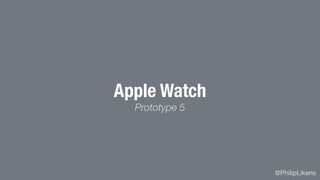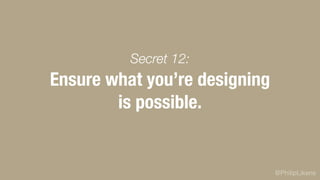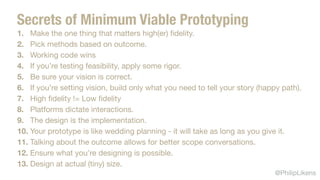Don't Waste Your Time: Secrets of Minimum Viable Prototyping
- 1. Don’t Waste Your Time: Secrets of Minimum Viable Prototyping Big (D)esign Conference 2015 @PhilipLikens
- 9. @PhilipLikens …and the Minimum Viable Product.
- 11. @PhilipLikens Sometimes you just need a prototype.
- 12. @PhilipLikens Sabre Labs makes a lot of prototypes.
- 13. @PhilipLikens
- 14. @PhilipLikens
- 15. @PhilipLikens
- 16. @PhilipLikens
- 17. @PhilipLikens
- 18. @PhilipLikens
- 19. @PhilipLikens
- 20. @PhilipLikens
- 21. @PhilipLikens And we’ve made a lot of mistakes.
- 22. @PhilipLikens “A prototype is worth a thousand meetings.”
- 23. @PhilipLikens “A prototype is worth a thousand meetings.” -Ron Burgundy
- 24. @PhilipLikens Thanks Ron. And yes.
- 25. @PhilipLikens …And if the average meeting is an hour long…
- 26. @PhilipLikens …then I can spend 999 hours on my pixel-perfect-printed-but-still-paper prototype and still be in the black?
- 28. @PhilipLikens Don’t waste your time.
- 33. @PhilipLikens Problem: We spent 3 months building the thing
- 34. @PhilipLikens Make the one thing that matters high(er) fidelity. Secret 1:
- 35. @PhilipLikens Type of Prototypes Conceptual prototype Work through a design–for designers and developers, prototypes act as a way to work through your design… Technical prototype Gauge technical feasibility–designers want to do X, but can engineering do it? Do we have the resources? Is it worth the effort? Vision prototype As a common communication platform– using them to get everyone on the same page… Consensus prototype Sell your idea internally–using them to sell your design solution to internal stake holders… Demo As a marketing tool–while similar to number 3, this is for an external audience. Todd Zaki Warfel / Joe Lamantia
- 36. @PhilipLikens Conceptual prototype Work through a design–for designers and developers, prototypes act as a way to work through your design… Technical prototype Gauge technical feasibility–designers want to do X, but can engineering do it? Do we have the resources? Is it worth the effort? Testing prototype? What you put in front of User Testing folks? Evolve / Test Vision prototype As a common communication platform– using them to get everyone on the same page… Consensus prototype Sell your idea internally–using them to sell your design solution to internal stake holders… Demo As a marketing tool–while similar to number 3, this is for an external audience. Communication
- 37. @PhilipLikens Pick methods based on outcome. Secret 2:
- 38. @PhilipLikens Problem: We built the thing
- 41. @PhilipLikens Problem: Their API was broken
- 42. @PhilipLikens If you’re testing feasibility, apply some rigor. Secret 4:
- 43. @PhilipLikens (again) Working code wins Secret 3:
- 45. @PhilipLikens Be sure your vision is correct. Secret 5:
- 47. @PhilipLikens If you’re setting vision, build only what you need to tell your story (happy path). Secret 6:
- 48. @PhilipLikens (again) Make the one thing that matters high(er) fidelity. Secret 1:
- 51. @PhilipLikens Our Product Auth Screenshot with button Error States Sign Up Other Product Auth
- 53. @PhilipLikens Problem: The fidelity lead to the wrong conversation
- 54. @PhilipLikens High fidelity != Low fidelity Secret 7:
- 55. @PhilipLikens Problem: Platform lead to the wrong interaction
- 57. @PhilipLikens The design is the implementation. Secret 9:
- 59. @PhilipLikens Problem: It took up too much time
- 60. @PhilipLikens Your prototype is like wedding planning - it will take as long as you give it. Secret 10:
- 61. @PhilipLikens Problem: We built functionality we didn’t need
- 62. @PhilipLikens Talking about the outcome allows for better scope conversations. Secret 11:
- 65. @PhilipLikens Ensure what you’re designing is possible. Secret 12:
- 67. @PhilipLikens Design at actual (tiny) size. Secret 13:
- 69. @PhilipLikens Don’t waste your time… Building the wrong type of prototype 2. Pick methods based on outcome. 3. Working code wins 7. High fidelity != Low fidelity 8. Platforms dictate interactions.
- 70. @PhilipLikens Don’t waste your time… “Building” beyond the minimum 1. Make the one thing that matters high(er) fidelity. 6. If you’re setting vision, build only what you need to tell your story (happy path). 10. Your prototype is like wedding planning - it will take as long as you give it. 11. Talking about the outcome allows for better scope conversations.
- 71. @PhilipLikens Don’t waste your time… Applying rigor in the wrong places 4. If you’re testing feasibility, apply some rigor. 5. Be sure your vision is correct. 9. The design is the implementation. 12. Ensure what you’re designing is possible. 13. Design at actual (tiny) size.
- 72. @PhilipLikens You stay classy, Dallas.
- 73. @PhilipLikens 1. Make the one thing that matters high(er) fidelity. 2. Pick methods based on outcome. 3. Working code wins 4. If you’re testing feasibility, apply some rigor. 5. Be sure your vision is correct. 6. If you’re setting vision, build only what you need to tell your story (happy path). 7. High fidelity != Low fidelity 8. Platforms dictate interactions. 9. The design is the implementation. 10. Your prototype is like wedding planning - it will take as long as you give it. 11. Talking about the outcome allows for better scope conversations. 12. Ensure what you’re designing is possible. 13. Design at actual (tiny) size. Secrets of Minimum Viable Prototyping

















